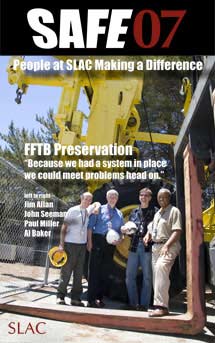

Tuesday - July 24, 2007
SLAC Today is available online at:
http://today.slac.stanford.edu
In this issue:
SAFE '07 Success Story: FFTB Preservation Project
ROB Features Local Art
Register for ALCPG07
Safety Seconds
 |
 |
|
Tuesday - July 24, 2007 |
SAFE '07 Success Story: FFTB Preservation Project
Photo courtesy of Diana Rogers; Poster design courtesy of SLAC InfoMedia.
SLAC's evolving research yard is a bustling place. Here, just beyond the beam switch yard, End Station A runs test beams, End Station B does research and development work for the International Linear Collider and advanced accelerators, experimental shops hum with activity, and other associated facilities support the lab's research programs. Last year, in the midst of all this activity, a team of SLAC employees, users and contractors completed the very complex Final Focus Test Beam (FFTB) Preservation Project, removing the installation to make way for the Linac Coherent Light Source (LCLS) Beam Transport Hall, without a single injury. "We had three tasks: first, we had to make the FFTB safe for the main removal of the facility, then we had to complete the actual removal, and finally we had to turn the area over to the conventional facilities group for construction," said Richard M. Boyce, Project Manager for the preservation project. "We accomplished all three of these very complex phases very safely through teamwork." Just days after the last experimenter left the building, the FFTB preservation team began its work, taking a fully operational beamline, powering it down, and securing the facility for component removal with an emphasis on preserving as many components as possible. Carefully considering safety issues, crews worked systematically to identify reusable components before disconnecting the FFTB's electrical, water and protection systems. Read more... |
||
|
|
||
ROB Features Local Art
The photographs depict narrow, winding trails separating vast sections of marshes that are saturated in vibrant reds, oranges, purples and yellows. The various colors make them seem part of some distant, alien world, yet the aerial pictures were taken only a few miles away from SLAC. The fascinating landscapes are caused by algae reacting to high salt levels of marshes in the San Francisco Bay, and were photographed by Eugene L. Berman, whose artwork goes on display in the Research Office Building tomorrow evening. All are invited view the art, meet Berman, and enjoy refreshments on Wednesday, July 25, at 4:30 p.m. Although Berman is a software engineer by trade, his photography shows he is an artist at heart. The colorings of the salt ponds first caught his eye during landing approaches on commercial flights. Later, while practicing flight maneuvers during pilot lessons, he again noticed the extraordinary coloring. But this time he was prepared, with his camera in tow. "Now I always take my camera with me flying," said Berman who began taking his photography more seriously five years ago. "When I'm not in a rush, I'm snapping pictures." The salt marsh photos, along with other aerial views of the San Francisco Bay area, are the newest collection to be shown in a series of art displays in the Research Office Building. To view more of Berman's art, visit his website. |
Register for ALCPG07
Registration is now open for American Linear Collider Physics Group '07 (ALCPG07), the next in a continuing series of North American regional meetings on the physics, detector and accelerator issues of the future International Linear Collider (ILC). The workshop will be held on October 22-26 at Fermilab. Key objectives for this meeting will
include presentation and discussion on progress toward the ILC Engineering
Design Report, as well as physics studies, detector R&D and integrated
detector design efforts. In parallel with the ALCPG07 meeting, the World
Wide Study will review the status of vertex detector R&D for the detector
concepts. Safety SecondsSome very experienced ex-pilot at the FAA called me back about our near-miss. To my horror, he told me that these kinds of errors are made all the time, and the pilots always double-check to make sure the tower has not told them to do something stupid, and that I should not worry about it. In other words, my safety in an airplane depends on the degree of vigilance of the pilots, and not just the "system." So, it is just like working at SLAC—if I want to never get injured, I have to be constantly vigilant. |
Events (see all | submit)
Access (see all)
Announcements
|
| | ||
|
|
||
 <%
Response.AddHeader "Last-modified", getArticleDate()
'Response.AddHeader "Last-modified","Mon, 01 Sep 1997 01:03:33 GMT"
'Monday, December 06, 2010
%>
<%
Response.AddHeader "Last-modified", getArticleDate()
'Response.AddHeader "Last-modified","Mon, 01 Sep 1997 01:03:33 GMT"
'Monday, December 06, 2010
%>View online at http://today.slac.stanford.edu/ |
||